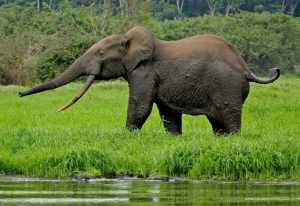We were edging along the Rembo Ngowe river in a small outboard, hugging the east bank in hopes of seeing a Giant Kingfisher or the Palm-nut Vulture, when we rounded a bend to suddenly come head to head with a magnificent Forest Elephant feeding on a grassy peninsula, its yellowish and relatively straight tusks nearly touching the ground. The animal stopped chewing, surveyed the situation, and deciding that we were too close for comfort, slowly backed away, disappearing rear-end first into a curtain of green…
We encountered the elephant in Loango, a 1550 square kilometer national park that fronts on the Atlantic Ocean in Gabon and we were here to learn about the Congo Rainforest Biome as well as hear about Gabon’s conservation successes. Loango has been called the ‘Eden of Africa’ and this may be the case, but Eden, like Shangri-La, is an overused word, one that connotes varying images to different people. Eden, to me, brings up a vision of a garden paradise where food supplies are inexhaustible, where plants and animals exist in balance, where animals roam without fearing man, a place of peace and beauty. Such may exist in one’s mind, but certainly not in western Gabon – at least not as yet.
However, if we were to say that Loango is an Elephant Eden we would not be far wrong, for Loango is indeed an elephant sanctuary, a place with a fairly uniformly hot climate, copious quantities of food, and with protection from hunters.
 |
|
We rounded a bend in a small outboard to suddenly surprise a
Forest Elephant, Loxodonta cyclotis, feeding on a grassy peninsula
poking into the slow-moving Rembo Ngowe river. While this animal
did not show alarm, it did stop eating and slowly backed into the forest.
The white bar at the lower left-hand edge of this picture shows the rim
of our boat and indicates how close we were to this magnificent creature.
|
As it was, I was surprised that this elephant backed into the forest as I couldn’t remember seeing elephants departing in this way – Savanna and Indian elephants usually swing around before fleeing. In addition, I had never been suddenly this close to a wild elephant without it showing considerable alarm. This morning there was no sign of aggression, no ears tilting forward, no trunk in the air, no trumpeting. This certainly spoke of the splendid protection afforded by the park and that the animal had not had bad encounters with humans.
The elephants that roam in Loango are Forest Elephants (Loxodonta cyclotis), a species that a DNA study published in 2001, showed was different from Savanna Elephants. Subsequent papers have confirmed this separation, and indeed the elephant in front of us did have a distinctive ‘feel’ to it. The tusker, even though fully mature and somewhat aged, did not seem inordinately large even at our close range and it also appeared to be a dark. We had read that the tusks of a Forest Elephant (when compared with a Savanna species), are straighter and yellower and ears are smaller, rounder. A Forest Elephant also has four, not five, toes, but we were so taken with the encounter that we forgot to count. In any case, the toes were well hidden in the grass.
The characteristics of these Gabon elephants are adaptations to a dense forest habitat, where small size would be useful, where relatively straight tusks would help to lift impeding vegetation out of the way, and where ear size, a part of their cooling system, would not be as necessary in forest shade as in open grasslands. In addition, a darker skin would blend with the darks of forest shade. But why four and not five toes? I have no idea.
Furthermore these elephants, as befitting their habitat, do not associate in large herds. During our time in Gabon, we encountered solitary animals, or a mother with a calf, or small groups of four or five animals. The largest gathering we saw was eight individuals clustered around a clump of trees in the middle of a wide, green marsh. Elephants also seek out clearings in the forest, locally called bais, where they are perhaps attracted by the soil’s mineral composition and where they associate with others,
Forest elephants move seasonally, frequenting soggy marshlands during the dry season and moving back into the lowland rain forests when the wet returns and the marshes flood. While in the marshlands, elephants feed on a variety of grasses and rushes, including papyrus, and in the forest they consume a wide variety of leaves, bark, and fruit. Some forest trees benefit from the presence of the elephants as the animals eat the fruit and then distribute seeds over wide areas. Indeed the seeds of some trees, including the 30-meter tall Navel Fruit, Omphalocarpumin the Sapotaceae family, germinate only if they have passed through the animal’s digestive system. In addition, the health of a forest may be assisted by the elephants breaking off branches and trampling the undergrowth to help light reach the ground and foster plant growth. In some parts of West Africa, the original forest composition has noticeably changed following the disappearance of elephants.
(Navel Fruit trees are part of what has been called the Megafaunal Syndrome which theorizes that in past ages very large fruit may have evolved in order to attract very large animals (the megafauna) and thus assist in wide seed dispersal (for more see Megagardeners of the Forest – the role of elephants in seed dispersal, by Ahimsa Campos-Arceiz and Stephen Blake in Acta Oecologica, posted online 22 Feb 2011).)
Any thought of elephants immediately brings to mind the grim straits that the Forest Elephant and all elephant species face. Elephants need space but with habitat loss and fragmentation this is a fast diminishing commodity. Besides space, rampant poaching is a dire on-going threat that will be eliminated only when human needs are adequately met and when there is no market for ivory – or bush meat. There are many on-going efforts to deal with poaching so we retain the hope that elephants will indeed survive in the wild.
Gabon had received little conservation attention and Loango was almost unknown until zoologist Michael Fey’s well-publicized on-foot transect across the Congo Basin, a journey that ended in Loango in 2000. With Longo now on the map, the forward thinking prime minister, Omar Bongo, created the National Agency for National Parks in 2002, and this body decided to protect thirteen areas of special biological interest as national parks. These now occupy ten percent of Gabon’s land area.
While elephants, as a charismatic group, attract special conservation interest, their protection and the retention of their habitat also benefits many other species which, in Gabon, includes Lowland Gorillas, Chimpanzees, Red River Hogs, African Gray Parrots, and Slender-snouted Crocodiles, all indicator species of the Congo Rainforest Biome. And also benefitting from habitat protection are Giant Kingfishers, Palm-nut Vultures, and the African Rock Python, species I had previously encountered in other areas of Africa – but never in these numbers.
 |
| The Red River Hog, Potamochoerus porcus, is one of 19 species is the family Suidae. These hogs search the forest floor in tropical rainforests of West Africa and are found from the Congo Basin west to Guinea. Their preferred habitat is good forest as well as open edges of streams and marshes where they search for tubers, fruit fallen from trees, and even carrion. In addition they look for the balls of forest elephant feces which they break apart to feed on the undigested seeds of trees such as Balanites wilsoniana. While Wild Red River Hogs usually roam in small groups of up to ten animals, the large assemblages seen in Loango indicates fine habitat and good protection. |
In the bird world, African Gray Parrots are perhaps the most accomplished mimics of the human voice but in the wild they don’t sound like humans at all. On the first morning at the Loango Lodge, I stepped outside my cottage to hear a melodic chorus some distance to the left. Those wonderful, mellow voices at varying pitches, sounded like orioles. But several orioles singing together? Most unlikely. This was a puzzle.
But not a puzzle for long as I was soon told that these were African Gray Parrots talking. Parrots singing like orioles? Seemed most improbable, as members of the parrot family screech and squawk. But sing? No way! So I walked over to the trees where the birds were moving about and sure enough: Gray Parrots.
In the bird world, Grays are perhaps the best imitators of the human voice (Talking Mynas are a close second) and Alex a captive Gray, one of the most famous representatives of its species, was taught to ‘say’ over 100 words. But not only that, this remarkable bird seemed to understand what the words meant. Additionally, it was demonstrated that Alex could count up to six and could recognize seven different colors (for a splendid biographical account see: Alex and Me by Irene Pepperberg, first published in 2008 by HarperCollins).
Gray parrots are much in demand as caged birds – and this poses a dilemma for this parrot, as it does for all cage bird species. In the past the capturing of wild birds (often chicks or eggs robbed from the nest) has been a income source for some but these days with tightened regulations through CITES treaties, heightened publicity of illegal acts, and well trained customs officials, the illegal bird trade has diminished – not finished but much reduced.
One good way to impede nefarious wildlife activities is to recruit the best village ‘poachers,’ and train them as ecotourism guides. When the economic benefit of guiding outweighs remuneration from poaching, the same hunters often make outstanding wardens. We saw this in action in Piaui State in Brazil where income is generated by showing visitors the stunning Hyacinth Macaw.
Iguela Lagoon, a large fresh water lake with brackish water towards the Atlantic Ocean, is a special feature of the northwestern part of the park. Much of the territory immediately around the lake is marshland, waterlogged during the rainy season, but transformed into vast grassy swards in the dry season. Slightly raised terrain inland from the lagoon, often small ridges, support stands of tropical forest in which animals such as White-nosed Monkeys and the Red River Hogs live. Forest elephants are at home in either terrain and when green grasses sprout during the dry season elephants emerge from the forest into the marshes.
Even during the short dry period, the time when we were in the park, the water channels running into Iguela Lagoon remain filled, but with banks exposed enough to host rows of palms, their long leaves often drooping over the water. And with the palm canopy punctuated by tall trees, this is a perfect habitat for the Palm-nut Vulture (Gypohierax angolensis).
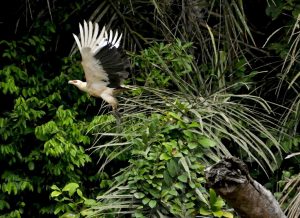 |
| The Palm-Nut Vulture (Gypohierax angolensis), a raptor primarily of wet equatorial forests in western Africa, might best be called a vulturine eagle for its head is totally feathered, save for red facial skin, and the bird features acrobatic aerial courtship displays, rolling and diving. Besides the bird sometimes attacks living prey, occasionally picking disabled fish off the surface of the water or eyeing the occupants of a chicken coop. This vulturine eagle does feed on carrion but its primary food source is nuts of Elaeis and Raphia palms. |
Eagles and Old World vultures are closely related and the Palm-Nut Vulture looks and acts like a black-and-white eagle, especially in aerial courtship displays and when attacking live creatures such as chickens. Their name is appropriate as these birds feed primarily on the nuts of the palms (especially Elaeis and Raphia), but they also consume dead fish – as do American Bald Eagles and the African Fishing Eagles. During our Gabon visit we did not see this species scavenge and thus the name Palm-nut Vulturine Eagle would be appropriate, or perhaps the alliterative Vegetarian* Vulture would be at least partly applicable.
Gabon is also a stronghold for the Slender- snouted Crocodile Mecistops cataphractus, one of four African crocodilian species. This rainforest reptile thrives best in shaded, aquatic situations and is known from the Congo Basin and surrounding regions as well as living in rainforest patches that extend west along the African coast to as far as Senegal. The crocodiles living in far western Africa may well represent a separate species. Whatever, population numbers are uncertain but the crocodile is usually listed as critically endangered and Gabon likely harbors one of the highest concentration of this species with Loango and its Iguela Lagoon and the shaded waterways is one of the best hopes for this species.
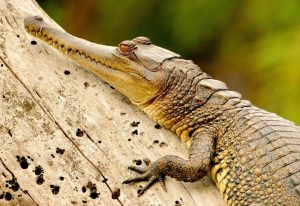 |
| On occasion, most crocodiles like to haul out of the water to spend time on dry land. However, few exposed banks exist along the Mpivie or other rivers in lowland Gabon, so Slender-snouted reptiles often clamber up trunks of dead trees fallen into the river. |
This, small, long-snouted crocodile (adults rarely run to more than three meters in length) is a fish eater, the snout slashing sideways when detecting prey. It also supplements its diet with aquatic reptiles (turtles are a favorite) and the occasional bird or mammal. From time to time, crocodiles like to haul out of the water but as very few open banks exist in Loango, the reptiles climb onto protruding logs, often managing to clamber up a dead tree trunk sticking out of the water at a slant of up to 25 degrees. In Loango the reptiles are not hunted for their meat or skins (as they are in many areas of this biome) so the animals we encountered were remarkably tolerant of our approach. However, if our boat floated too close for comfort, the crocodiles suddenly launched off the logs and belly flopped into the water.
This crocodile is a mound nester, and towards the beginning of the rainy season a female will gather vegetation into a pile on the bank and then lay around 20 large eggs in the mound. These eggs take a long time to hatch, one report listed 110 days, during which period the female stays near the nest but does not assist with incubation. However, when the youngsters begin to cheep as the eggs hatch, the female digs into the mound to free her offspring so they can swim out into the flooded marshes.
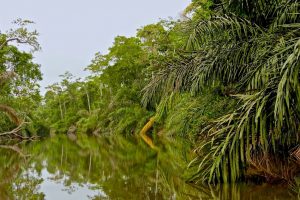 |
|
The slow-moving, shaded Mpivie River is ideal habitat for Slender-snouted Crocodiles as it supports a splendid fish population and there is ample shade from the Eleias palms and other trees lining the channel. This habitat is also much favored by kingfishers as well as the African Finfoot and the large, Pell’s Owl, both rare bird species.
|
Gabon’s thirteen national parks are the ‘top down’ variety, reserves imposed by officials on areas of special conservation interest. One does need to start somewhere but in the long run, the top-down system has been effective – over the long haul – mostly where initiation has been followed by strong community outreach and where people living in or near the protected areas are incorporated into the economic benefits of the conservation plan. Without community cooperation, and the members assisting in surveillance to help maintain their economic asset, most plans don’t succeed, or succeed only if governments invest huge amounts of money in order to patrol the area.
No two conservation areas are alike so programs need to be flexible and adapt to what works within the given context, and in Gabon we can be thankful both for the government initiatives and also for the evolution of conservation thinking has led to a point where locals are included, not excluded, in plans.
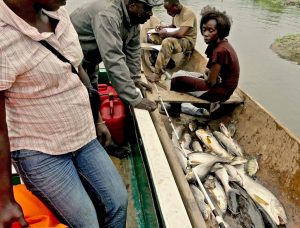 |
|
Much of the terrain inland from Gabon’s southern Atlantic coast features a mosaic of lagoons and waterways, and the people living here are masterful fishermen. Hunting in Loango National Park is not permitted but fishing for local consumption is allowed, the operations supervised by park authorities. This mid-afternoon image shows a park ranger recording the ‘take’, which includes catfish and other freshwater species while staff from the Akaka tented camp bargain for dinner.
|
A multiuse concept covering areas of special significance, initially voiced in the 1970s, works well in many places. This scheme envisions three zones – or adaptations thereof. A core zone is a strictly protected area where entry is granted by special permission. This is surrounded by a buffer zone where limited, sustainable use activities, including low impact tourism and recreation is promoted. And all are flanked by an outlying transition zone in which people live and where sustainable economic activity, such as ecotourism lodges or selected logging, is encouraged and where various stakeholders work together to ensure a long-term, on-going benefit to the people in the area.
Gabon still has a long road ahead to reach the point where their national parks are protected for the long term, but a fine start has been made so future generations of elephants as well as people can be thankful for the vision and the effort that is evident today.
_______________________________________
 |
|
Pictured is Dr. Fleming with a staff member of
Loango Lodge; the photo was taken on‘Gorilla Island’ near the
Loango National Park where there is a rehab center for rescued gorillas.
|
This week’s blog piece and photos make up the fourth installment in our Musings of a Naturalist series, courtesy of our own Dr. Robert (Bob) Fleming: Professor Equity and Empowerment/ Natural History. Having grown up in the foothills of the Himalayas in India, Bob has long been interested in the beauty of nature. This progressed into a fascination with natural history and cultural diversity, leading him to obtain his Ph.D. in zoology. He has explored many of the planet’s special biological regions, ranging from the Namib Desert in Africa to the Tropical Rainforest of the Amazon, and the Mountain Tundra biome of the Himalayas. He has worked for the Smithsonian’s Office of Ecology and the Royal Nepal Academy and, along with his father and Royal Nepal Academy Director-Lain Singh Bangdel, he wrote and illustrated “Birds of Nepal,” the first modern field guide to the birds of the region. In addition to his work with Future Generations, Bob is the director of Nature Himalayas, a sole proprietorship that he began in 1970. Through this company, Bob has led some 250 outings. He currently lives in the temperate rainforest of western Oregon in the USA’s Pacific Northwest.
Many thanks to Dr. Fleming for another great contribution!





